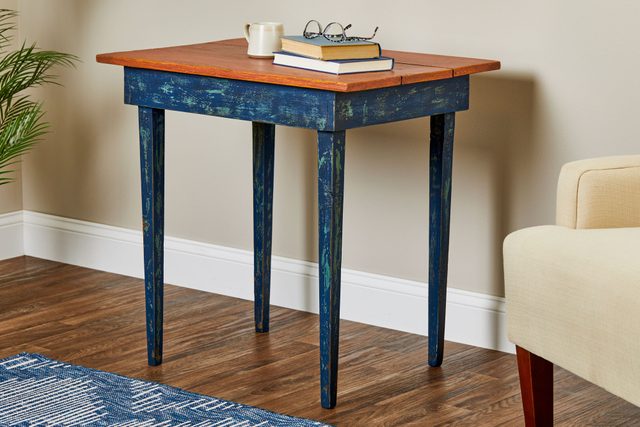Transform ordinary pieces with these furniture distressing techniques.
A full day
Beginner
$10 - $60
Introduction
In this project, you'll learn how to distress furniture with chalk paint and glaze to breathe new life into tired or boring pieces.
Before I got into woodworking, I fell headfirst into decorative finishes and textures. Paint was my entry into the DIY world, and I fell in love with its endless possibilities. When it comes to creating a piece of furniture with rustic charm, why not use a piece of furniture you were going to discard, save money and have some DIY fun?
For this furniture transformation, I chose to paint the legs and top in different, complementary colors: blue chalk paint and brown antiquing glaze for the legs and yellow flat paint with fired clay chalk paint and brown antiquing glaze on the top.
Start with the table’s legs, as it is easier to work with them on a table and then turn them over to finish the top. Work smarter, not harder, applies here!
Choosing the right piece of furniture to distress
Choose solid wood furniture. Avoid laminates, plastic, or manmade veneers. These will reject finishes, leaving peeling and chipped paint.
Is it oil-based? If you think the piece you want to distress has an oil-based varnish or sealer, give it a light scratch coat with sandpaper and apply two coats of primer to ensure the paint you are applying will stick and bond for the life of the furniture. Not sure? Prime it!
Tools Required
- Detail sander
- Painting supplies
Materials Required
- Assorted sandpaper / sanding blocks
- Chalk paint
- Chip brushes
- Cotton painter's rags
- Decorative glaze
- Furniture wax
- Paint
- Paraffin wax or candle
- TSP (Phosphate free)
- water-based polyurethane
Project step-by-step (14)
Clean the surface to be painted
Clean the surface with a mixture of water and phosphate-free TSP (it comes in powder or liquid form). Use a sponge or paint rags to remove dust, dirt, and grime. If necessary, lightly sand with 150-grit sandpaper to remove flaking and chipped paint.
For paint to bond well to a surface, it is very important to apply it over a clean, dust-free surface. Any grease, dust or grime left on the surface and painted over will very quickly reject the coats of paint, creating cracks, chipping and peeling. Ultimately, not cleaning the surface well will compromise your finished project.

Scuff the surface with sandpaper
For the surface to accept the first layer of primer, lightly scuff it with 180-grit sandpaper. This is called giving the surface “teeth” for this first coat to bite into and grab on. You aren’t trying to remove any of the previous finish, you are just scratching it up. This is especially crucial if you believe you are transitioning from an oil-based to a water-based finish.

Apply a coat of primer
Apply a coat of primer. If you suspect you are transitioning your piece of furniture from oil-based to water-based, apply two coats of primer. Allow the primer to dry completely.

Apply paint
Apply a solid coat of blue chalk paint (nautical blue) to the table’s legs and apron over the primer. Allow the paint to dry thoroughly.

Sand back edges and corners
With 100-grit sandpaper and a detail sander, sand the edges and corners. Focus on edges and high spots of the furniture to sand and reveal the under layers of paint and raw wood. Think of sanding places where the piece of furniture would naturally be rubbed and worn. Then, transition to 180-grit sandpaper and sand back the revealed edges to smooth and blend them.

Apply decorative glaze
To give it an even further aged/antique look, use a pre-mixed brown decorative glaze. Brush on with a chip brush, then wipe the excess off with a paint rag. The brown glaze will embed into the low points of the wood and be wiped off on the highs. Wipe the rag in the grain direction of the piece of wood.

Apply a coat of primer to the top
Flip the piece over and apply a coat of primer on the tabletop. As stated before, if you suspect you are transitioning your piece of furniture from oil-based to water-based, apply two coats of primer and allow them to dry well.

Paint the top
Apply a solid coat of yellow flat paint to the tabletop over the primer. Allow it to dry fully.

Apply “resist” wax
Once the yellow paint has dried, use a candle or paraffin wax to rub along the edges of your table and then lightly rub over the top itself. The wax serves as a “resist,” which means it prevents the next coat of paint from adhering or bonding wherever it is rubbed on. This makes it easier to remove the paint when sanding back for an aged and distressed look.

Paint the second color on the top
Apply a generous coat of the fired clay chalk paint over the yellow to cover the whole tabletop. Yes, paint right over the wax resist rubbed on earlier. Allow it to dry.

Sand back edges and corners of the top
With a 150-grit sanding block and a detail sander, sand the edges and corners. Focus on edges and high spots of the furniture to sand back and reveal the yellow layer. Focus on areas where you applied the wax resist, and the paint will come off easily with the sanding process. If necessary, sand with 180-grit sandpaper to even out the paint for a smooth finish. Now, you should have some of the yellow paint showing through under the fired clay.

Apply decorative glaze to top
Brush on and wipe off with a paint rag a coat of the pre-mixed brown decorative glaze. For the tabletop, brush the glaze on and wipe it back in the direction of the wood grain.

Seal the table (Optional)
Seal the table with a water-based polyurethane or furniture wax. Sealing it with furniture wax will prevent you from adding more paint in the future. And over time, wax wears off or soaks in, so it isn’t truly protected for longevity.

FAQ
Can I make my own antiquing glaze?
Yes, you can make your own antique glaze out of any color. Mix one part satin or flat paint (color of your choice) to three parts transparent decorative paint glaze. Mix well, apply with a brush, and wipe back with a clean paint rag. Always do a test before applying to your surface.
Do I need an electric or battery-operated sander, or can I distress a piece of furniture by hand?
An electric or battery-operated sander will make things go faster and cause less wear and tear on your hands and arms, but you can absolutely do it all by hand.




















